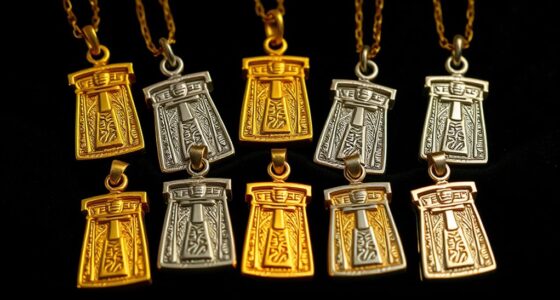If you’re looking for the top Penrose tiling puzzles that challenge your mind and ignite creativity, I’ve found some fantastic options. These puzzles range from intricate geometric designs to visually stunning mosaics, perfect for puzzle enthusiasts of all skill levels. They combine mathematical insight with artistic beauty, offering hours of engaging fun. Keep exploring, and you’ll discover the best choices to test your skills and inspire your imagination.
Key Takeaways
- Top Penrose tiling puzzles feature complex, non-periodic geometric patterns that challenge spatial reasoning and pattern recognition skills.
- The best puzzles are made from high-quality materials like sturdy cardboard or plastic for durability and precise pattern reproduction.
- Size varies from portable 12×12 inch designs to large wall-sized mosaics, catering to different skill levels and display preferences.
- Authentic puzzles accurately replicate Penrose’s aperiodic tilings, ensuring geometric fidelity and visual appeal.
- Advanced options incorporate intricate transformations and non-repeating patterns that stimulate creativity and critical thinking.
The Moscow Puzzles: 359 Mathematical Recreations
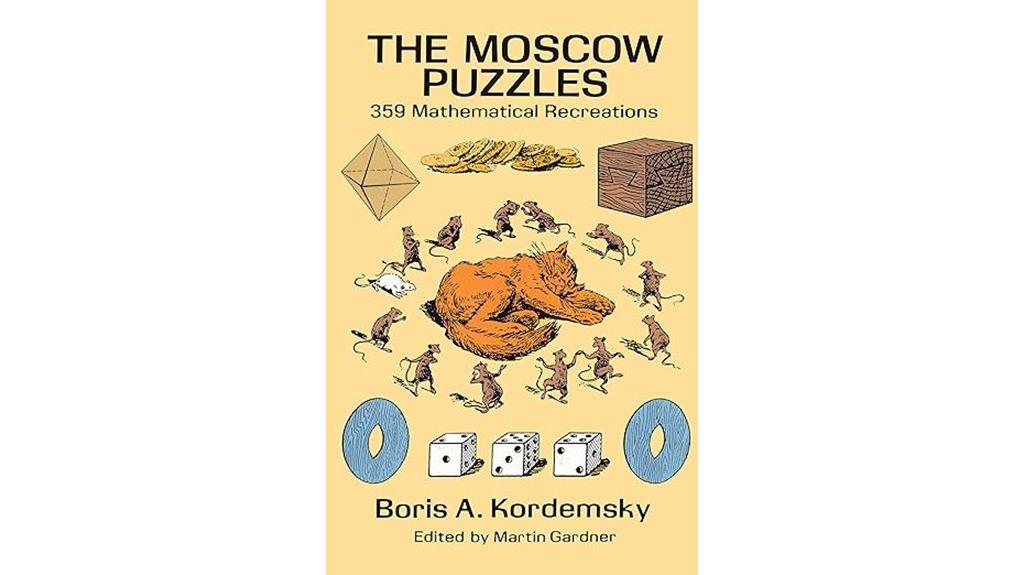
If you’re someone who loves challenging puzzles that blend mathematics, logic, and history, “The Moscow Puzzles: 359 Mathematical Recreations” is an excellent choice. I found this book to be a treasure trove of brainteasers, ranging from simple warm-ups to some of the hardest puzzles I’ve ever encountered. It’s perfect for sharpening your analytical skills and encouraging outside-the-box thinking. The puzzles often require multiple steps, resourcefulness, and even some background knowledge, making each challenge a rewarding mental workout. Whether you’re a student, teacher, or puzzle enthusiast, this collection offers a stimulating blend of entertainment and education.
Best For: puzzle enthusiasts, students, and educators seeking to enhance their logical reasoning and problem-solving skills through challenging mathematical and logical riddles.
Pros:
- Offers a wide range of puzzles from easy warm-ups to extremely difficult challenges, suitable for all skill levels.
- Combines mathematical, logical, and historical elements, enriching the learning experience.
- Stimulates creative thinking and analytical skills, making it both educational and entertaining.
Cons:
- Some puzzles may be time-consuming and require paper, patience, and multiple steps to solve.
- Minor translation issues or typos can occasionally cause confusion or misinterpretation.
- The increasing difficulty level might be overwhelming for beginners or casual puzzle solvers.
300+ Mathematical Pattern Puzzles: Number Pattern Recognition & Reasoning

Mathematical pattern puzzles excel at engaging those who enjoy recognizing sequences and logical relationships, making them ideal for learners seeking to sharpen their reasoning skills. I’ve found that working through number pattern recognition challenges boosts mental agility and offers a satisfying sense of accomplishment. Many readers share this experience, describing these puzzles as engaging brain workouts that can be both fun and nostalgic. The structured approach, gradually increasing difficulty, helps beginners grasp essential concepts while providing enough challenge for more advanced solvers. Whether as a solo activity or a social game, these puzzles are excellent for developing pattern recognition, logical thinking, and math fluency.
Best For: enthusiasts of math puzzles, students preparing for exams, and families seeking engaging brain games that improve pattern recognition and logical reasoning.
Pros:
- Offers a wide variety of puzzles suitable for all skill levels, from beginners to intermediate learners.
- Structured to gradually increase in difficulty, helping users build confidence and skills over time.
- Promotes mental agility, pattern recognition, and math fluency in an enjoyable, engaging format.
Cons:
- Some puzzles may be too simple or repetitive for advanced puzzle solvers seeking greater challenges.
- Answers are located at the end of the book, which can be inconvenient for quick reference during practice.
- Occasionally lacks variation in difficulty levels, leading to a less stimulating experience for experienced users.
Magical Mathematics: The Mathematical Ideas That Animate Great Magic Tricks
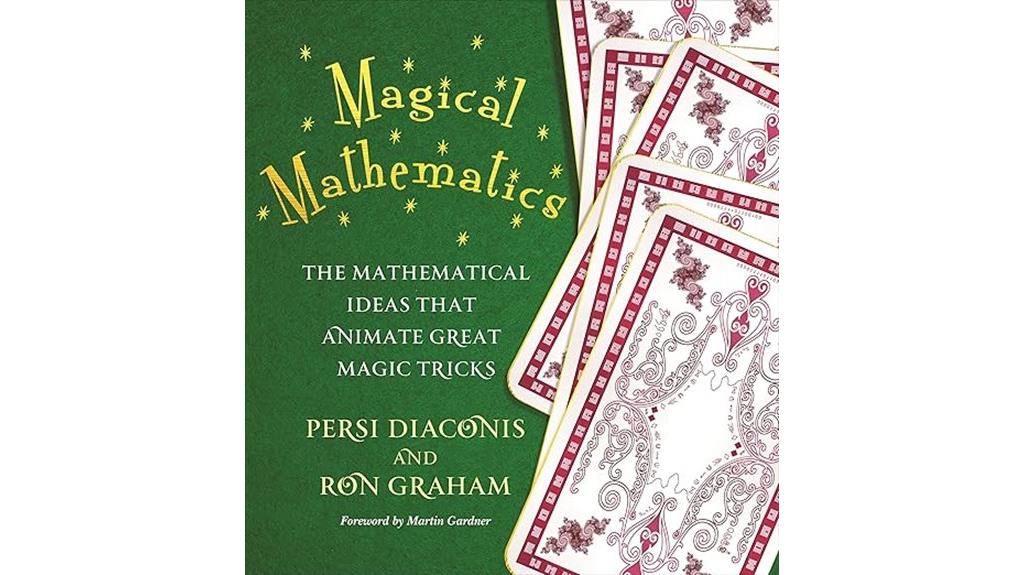
Magical Mathematics: The Mathematical Ideas That Animate Great Magic Tricks is perfect for anyone curious about the secret science behind mesmerizing card tricks. I find it fascinating how math concepts like combinatorics, group theory, and graph theory underpin many illusions. The authors reveal how techniques such as perfect shuffles or De Bruijn sequences create seemingly impossible effects. While some explanations are complex, the book offers practical tips for mastering tricks through understanding their mathematical roots. It’s a blend of storytelling and education that sparks curiosity, showing how mathematics isn’t just abstract but a powerful tool to entertain and amaze.
Best For: enthusiasts of mathematics, amateur magicians, and puzzle lovers interested in understanding the science behind magic tricks.
Pros:
- Engaging storytelling that makes complex mathematical ideas accessible
- Demonstrates real magic tricks that can be performed after understanding the principles
- Inspires curiosity and appreciation for the connection between math and magic
Cons:
- Superficial explanations and proofs for some advanced concepts
- Limited coverage of some existing magic literature and techniques
- Some sections may be challenging for readers without a strong math background
Stained Glass Tree of Life Puzzle, 1000 Pieces
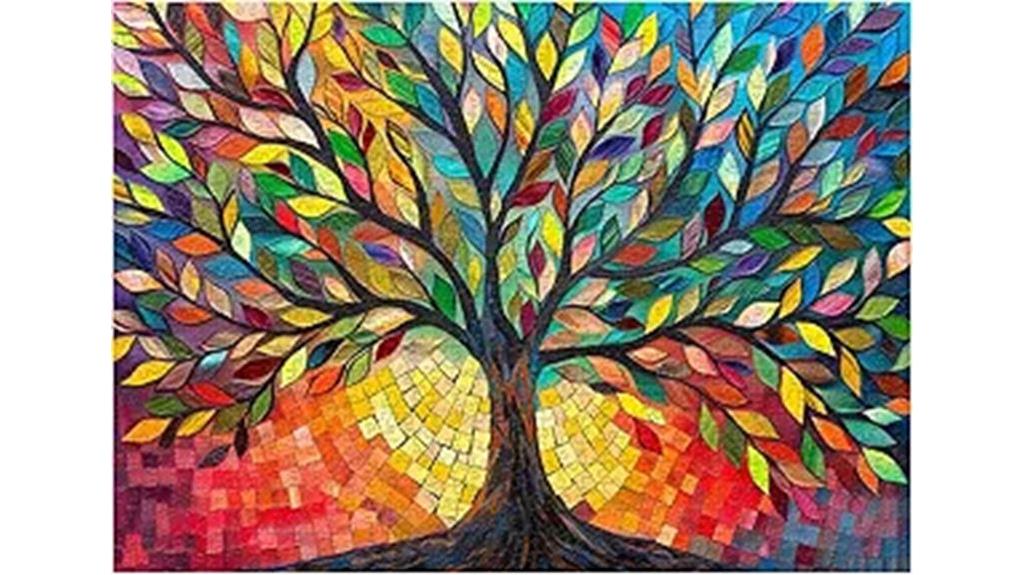
The Stained Glass Tree of Life Puzzle, 1000 pieces, stands out as an ideal choice for puzzle enthusiasts who enjoy both visual complexity and artistic beauty. Its vibrant mosaic design features a colorful tree with smooth gradients from greens to warm oranges and reds, set against a sunset-like background. Measuring 27.5 by 19.7 inches, it offers a challenging yet rewarding experience. Made of durable, thick cardboard with a high-resolution poster included, it’s designed for long-term assembly. The bright colors and elegant packaging make it perfect as a decorative wall piece or a thoughtful gift for anyone who loves intricate, eye-catching puzzles.
Best For: puzzle enthusiasts and home decorators seeking a challenging, vibrant, and artistic 1000-piece mosaic puzzle to enjoy and display.
Pros:
- Bright, colorful design with vibrant gradients for visual appeal
- Durable construction with thick cardboard and included poster for reference
- Ideal size for framing or wall decor, offering long-term engagement
Cons:
- Slightly high difficulty may be challenging for beginners
- Requires ample space and time for assembly due to complexity
- Made in China, which may be a consideration for some buyers regarding manufacturing origin
Brainteasers and Riddles for Kids
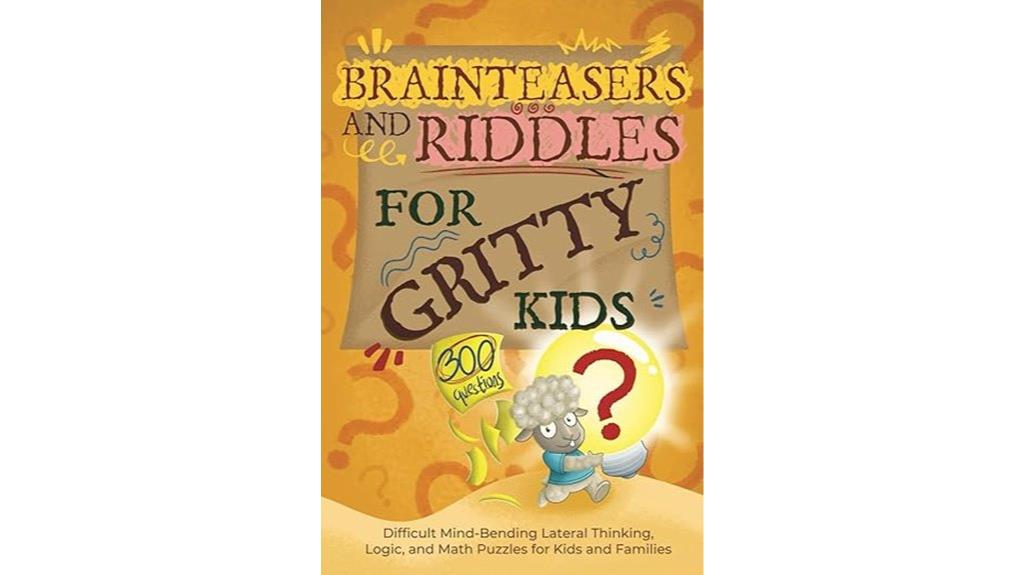
Are you looking for brainteasers that truly challenge kids and ignite their curiosity? “Brainteasers and Riddles for Gritty Kids” offers a collection of puzzles designed to sharpen critical thinking, problem-solving, and logical skills. This activity book is highly regarded for its quality and engaging content, making it a valuable investment in children’s development. Kids love the puzzles, often wanting to do “just one more,” while parents and grandparents enjoy solving them together. It’s an excellent way to entertain children and promote mental growth, all while fostering family bonding through shared problem-solving adventures.
Best For: parents, grandparents, and educators seeking engaging, challenging puzzles to boost children’s critical thinking and family bonding.
Pros:
- Enhances cognitive skills such as logic, problem-solving, and lateral thinking.
- High-quality content that provides long-lasting entertainment and educational value.
- Encourages family participation and shared problem-solving experiences.
Cons:
- Some puzzles may be too difficult for very young children without adult assistance.
- The extensive variety of puzzles might be overwhelming for casual users.
- May require adult supervision or guidance to maximize learning and enjoyment.
Nonogram Puzzle Book with 400 Puzzles
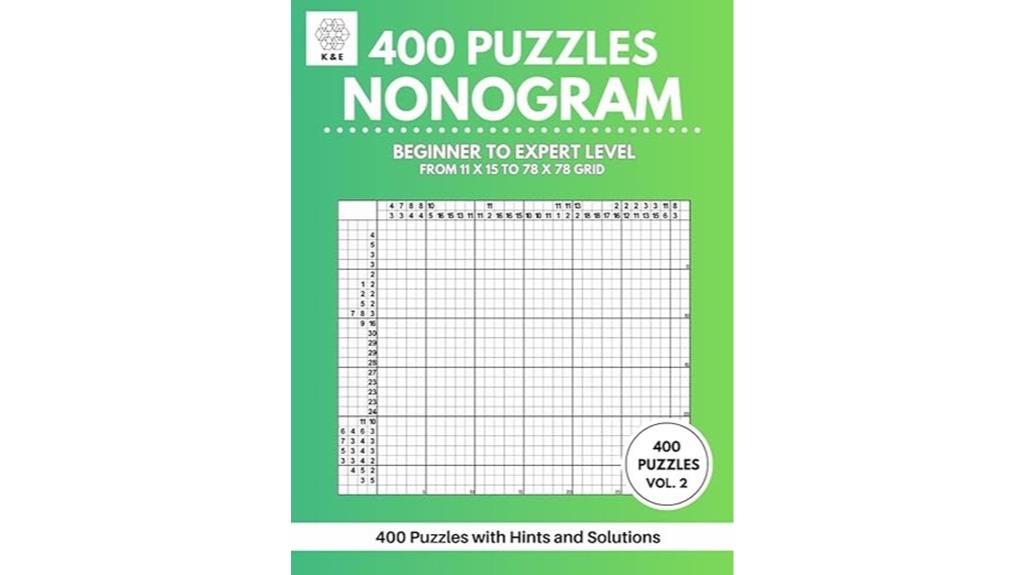
A Nonogram Puzzle Book with 400 puzzles is ideal for dedicated puzzle enthusiasts seeking variety and long-term challenge. It offers puzzles from easy to expert levels, keeping you engaged as you progress. Some find the initial puzzles a bit simple but appreciate the increasing difficulty for a real test of skill. The well-designed squares and beautiful images make solving satisfying and visually appealing. QR codes for hints and solutions save space and make solving more efficient, though scanning can sometimes be tricky. While some wish for sturdier binding and cleaner layouts, overall, this collection provides hours of fun and a rewarding puzzle experience.
Best For: dedicated puzzle enthusiasts of all skill levels who enjoy long-lasting, visually appealing nonogram challenges with a variety of difficulty options.
Pros:
- Offers a wide range of puzzles from easy to expert, providing long-term engagement.
- Features gorgeous images and perfect-sized squares that enhance visual appeal.
- QR codes for hints and solutions save space and improve solving efficiency.
Cons:
- Some users find the binding and page quality could be more durable, suggesting spiral binding for better longevity.
- Extra margins around puzzles are unnecessary and can be distracting.
- Scanning QR codes can sometimes be problematic due to phone camera issues or errors.
Factors to Consider When Choosing Penrose Tiling Puzzles

When choosing a Penrose tiling puzzle, I consider factors like complexity, material quality, and size to find the best fit. It’s also important to look at the puzzle’s detail and accuracy, as well as its price for value. These points help me select puzzles that are both enjoyable and practical.
Complexity and Difficulty Level
Choosing the right Penrose tiling puzzle depends heavily on your current skill level and familiarity with geometric patterns. Puzzles range from simple pattern recognition to complex mathematical constructions, so it’s important to match the challenge to your abilities. Difficulty is often categorized by the number of tiles, pattern intricacy, and whether you’re creating or identifying the tiling. More advanced puzzles demand understanding concepts like non-periodic tilings and geometric transformations, which can considerably increase difficulty. Beginners should opt for puzzles labeled as introductory or beginner-friendly, allowing them to build confidence gradually. Keep in mind that more challenging puzzles tend to require hours or even days to complete, so choose one that aligns with your time availability and patience level.
Material and Durability
Selecting the right materials for a Penrose tiling puzzle is key to guaranteeing it stays in great shape through repeated handling. I recommend choosing sturdy materials like thick cardboard or high-quality plastic, which resist warping and deformation over time. Durable materials keep the pattern accurate and visually appealing, even after multiple assemblies. Pay attention to the surface finish; matte or semi-matte surfaces help reduce glare, making intricate tile details easier to distinguish. Additionally, the edges should be precisely cut from strong material to ensure a snug fit and prevent fraying or tearing. High-quality materials not only enhance the puzzle’s durability but also extend its lifespan, making it suitable for long-term display or frequent use. Investing in these aspects guarantees your puzzle remains a delightful challenge for years to come.
Visual Accuracy and Detail
To guarantee your Penrose tiling puzzle delivers an authentic and visually stunning experience, it’s essential to examine its accuracy and detail. Ensure the puzzle accurately reproduces the iconic aperiodic pattern with precise tiling and geometric details. High-resolution printing is vital to capture the intricate shapes and subtle color variations that give Penrose patterns their visual complexity. Check that the pieces fit together seamlessly, maintaining sharp angles and the fidelity of the tessellation. Verify that all key elements, like kites and darts or rhombs, are correctly proportioned and symmetrical. Finally, assess whether the artwork preserves the pattern’s mathematical and aesthetic integrity, providing an authentic and enthralling visual representation of Penrose tilings.
Puzzle Size and Dimensions
The size of a Penrose tiling puzzle plays a crucial role in shaping both its difficulty and visual impact. Larger puzzles, such as those over 36×48 inches, feature more intricate patterns and require more time and patience to complete. Smaller sizes, around 12×12 inches, are more portable and manageable, making them ideal for casual use or limited space. The physical dimensions also influence the level of detail, with bigger puzzles showcasing finer pattern complexities. When choosing a puzzle, consider your available display space and skill level. Some puzzles are designed to fit specific frames or walls, so selecting the right size can enhance both your solving experience and the final presentation. Balancing size with your space and patience ensures maximum enjoyment.
Price and Value
When choosing a Penrose tiling puzzle, considering its price relative to its design complexity and uniqueness helps guarantee you get good value for your money. While higher-quality puzzles with durable materials and intricate patterns may cost more, they often provide better long-term satisfaction and reusability. Comparing prices across sellers can help you find authentic, well-crafted puzzles without overpaying. Some puzzles also offer educational or decorative benefits, adding extra value beyond mere entertainment. It’s important to balance cost with features like size, difficulty level, and included instructions to ensure you select a puzzle that fits your budget and meets your expectations. Ultimately, investing wisely guarantees you enjoy a challenging, beautiful puzzle that offers lasting value.
Frequently Asked Questions
What Is the History Behind Penrose Tiling Discoveries?
You’re curious about the history behind Penrose tiling discoveries. I find it fascinating! I’ve learned that mathematician Roger Penrose first discovered these intricate patterns in the 1970s. He was inspired by the idea of non-repeating, aperiodic tilings that challenge traditional symmetry. His work revolutionized how we see patterns, especially in nature and art. It’s incredible how his discoveries continue to inspire both mathematicians and artists today.
How Can Penrose Puzzles Improve Spatial Reasoning Skills?
Imagine your mind as a vast, intricate maze. Tackling Penrose puzzles is like exploring this maze with a new map, sharpening your spatial reasoning. I find that working through these puzzles trains my brain to recognize patterns, understand geometry, and visualize complex structures. It’s like exercising your mental muscles, making you better at solving real-world problems that require a keen sense of space and spatial relationships.
Are Penrose Tiling Puzzles Suitable for Beginners or Only Experts?
You’re wondering if Penrose tiling puzzles are suitable for beginners or only experts? I’d say they can be great for both, depending on the puzzle’s complexity. Beginners can start with simpler designs to grasp the basics, while experts can challenge themselves with more intricate patterns. I recommend choosing puzzles that match your skill level and gradually increasing difficulty to build confidence and deepen your understanding of these fascinating patterns.
What Materials Are Best for Creating Durable Penrose Puzzles?
Imagine if Da Vinci had access to modern materials—that’s how I feel about choosing the right ones for Penrose puzzles. I recommend using sturdy cardstock or foam board for durability, as they resist wear and tearing. If you want something premium, acrylic sheets work beautifully, offering both longevity and a sleek look. These materials guarantee your puzzle withstands time, sparking creativity without falling apart easily.
How Do Penrose Tilings Relate to Real-World Applications?
Penrose tilings connect to real-world applications through their unique properties. I see them inspiring designs in architecture, where their non-repeating patterns create visually stunning structures. They also influence materials science, helping researchers understand quasicrystals’ atomic arrangements. Additionally, Penrose tilings appear in art and computer graphics, sparking creativity. I find it fascinating how these mathematical patterns bridge theory and practical use, enriching various fields with their intricate beauty.
Conclusion
Ready to challenge your mind with Penrose tiling puzzles? These intricate designs will spark your creativity and test your reasoning, much like solving a Rubik’s Cube in the age of smartphones. Whether you’re a seasoned puzzle enthusiast or just curious, diving into these patterns is like opening a secret portal to mathematical wonder. So, grab one and let your imagination run wild—because, after all, the only thing better than solving a puzzle is the thrill of discovery.





